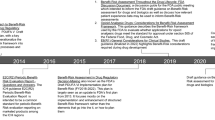Abstract
Assessing the utility of structured approaches to benefit-risk assessment of medicinal products is challenging, in part due to the lack of a gold standard for results and the uncertainty inherent in the data. In place of conducting formal testing, obtaining feedback from users of structured approaches provides insight into their value and limitations. The authors conducted a simulated single-session benefit-risk decision in which 3 groups applied the PhRMA BRAT(Pharmaceutical Research and Manufacturers of America Benefit-Risk Action Team) framework or the multicriteria decision analysis approach. The groups were provided with background and data for a hypothetical triptan for acute migraine in a population with cardiovascular risk factors and were asked to determine and defend an approval decision. Three insights emerged consistently from the groups: (1) the value of a structured approach to benefit-risk assessment, (2) the clarity provided by real-time visualization tools, and, most critically, (3) the importance of bringing the patient into the discussion early.
Similar content being viewed by others
References
Walker S, Liberti L, McAuslane N, Levitan BS. Refining the benefit-risk framework for the assessment of medicines: valuing and weighting benefit and risk parameters. Clin Pharmacol Ther. 2011;89:179–182.
European Medicines Agency. Benefit-risk methodology project: EMA/213482/2010. http://www.ema.europa.eu/docs/en_GB/document_library/Report/2010/04/WC500089603.pdf. Accessed April 25, 2014.
Coplan PM, Noel RA, Levitan BS, Ferguson J, Mussen F. Development of a framework for enhancing the transparency, reproducibility and communication of the benefit-risk balance of medicines. Clin Pharmacol Ther. 2011;89:312–315.
Levitan BS, Andrews EB, Gilsenan A, et al. Application of the BRAT framework to case studies: observations and insights. Clin Pharmacol Ther. 2011;89:217–224.
FDA Center for Devices and Radiological Health. Guidance for industry and Food and Drug Administration staff: factors to consider when making benefit-risk determinations in medical device premarket approval and de novo classifications. http://www.fda.gov/downloads/MedicalDevices/DeviceRegulationandGuidance/GuidanceDocuments/UCM296379.pdf. Published March 28, 2012. Accessed April 25, 2014.
FDA. Structured approach to benefit-risk assessment in drug regulatory decision-making. http://www.fda.gov/downloads/ForIndustry/UserFees/PrescriptionDrugUserFee/UCM329758.pdf. Published 2013.
Innovative Medicines Initiative PROTECT Project. http://www.imi-protect.eu/index.shtml. Published 2012. Accessed October 22, 2012.
Nixon R, Waddingham E, Mt-Isa S, et al. IMI PROTECT WP5 IMI report 2:b:iv natalizumab wave 2 case study report. http://www.imi-protect.eu/documents/NixonetalBenefitRiskWave2CasestudyReportNatalizumabMarch2013.pdf. Published 2013.
Nixon R, Stoeckert I, Hodgson G, Pears J, Tzoulaki I, Montero D. IMI WP5 report 1:b:iv benefit-risk wave 1 case study report: NATALIZUMAB. http://www.imi-protect.eu/documents/NixonetalBenefitRiskWave1casestudyreportNatalizumabMay2013.pdf. Published 2013.
Juhaeri J, Mt-Isa S, Chan E, Genov G, Hirsch I, Bring J. IMI work package 5: report 1:b:i benefit-risk wave 1 case study report: rimonabant. http://www.imi-protect.eu/documents/JuhaerietalBenefitRiskWave1CasestudyreportRimonabantOct2011.pdf. Published 2011.
Lipton RB, Bigal ME, Diamond M, Freitag F, Reed ML, Stewart WF. Migraine prevalence, disease burden, and the need for preventive therapy. Neurology. 2007;68:343–349.
Straube A, Pfaffenrath V, Ladwig KH, et al. Prevalence of chronic migraine and medication overuse headache in Germany: the German DMKG headache study. Cephalalgia. 2010;30:207–213.
National Headache Foundation. Migraine fact sheet. http://www.headaches.org/education/Headache_Topic_Sheets/Migraine. Accessed October 22, 2012.
World Health Organization. Global Burden of Disease Study. Geneva, Switzerland: World Health Organization; 2000.
Bigal ME. Migraine and cardiovascular disease. Arquivos de neuro-psiquiatria. 2011;69:122–129.
Schurks M, Rist PM, Bigal ME, Buring JE, Lipton RB, Kurth T. Migraine and cardiovascular disease: systematic review and meta-analysis. BMJ. 2009;339:b3914.
Catalyze Ltd. Hiview3. http://www.catalyze.co.uk/.
Dodgson JS, Spackman M, Pearman A, Phillips LD. Multi-criteria Analysis: A Manual. London, UK: Department for Communities and Local Government; 2009.
Zafiropoulos N, Phillips L, Pignatti F. Evaluating benefit-risk: an agency perspective. Regulatory Rapporteur. 2012;9(6):5–8.
Levitan B. A concise display of multiple end points for benefit-risk assessment. Clin Pharmacol Ther. 2011;89:56–59.
FDA. Rivaroxaban Cardiovascular and Renal Drugs Advisory Committee [briefing document]. http://www.fda.gov/downloads/AdvisoryCommittees/CommitteesMeetingMaterials/Drugs/CardiovascularandRenalDrugsAdvisoryCommittee/UCM272005.pdf. Published September 8, 2011.
FDA. Belatacept Cardiovascular and Renal Drugs Advisory Committee [briefing document]. http://www.fda.gov/downloads/AdvisoryCommittees/CommitteesMeetingMaterials/Drugs/CardiovascularandRenalDrugsAdvisoryCommittee/UCM203517.pdf. Published March 1, 2010.
FDA. Tanezumab Arthritis Advisory Committee [briefing document]. http://www.fda.gov/downloads/AdvisoryCommittees/CommitteesMeetingMaterials/Drugs/ArthritisAdvisoryCommittee/UCM295205.pdf. Published February 8, 2012.
Miller GA. The magical number seven plus or minus two: some limits on our capacity for processing information. Psychological Review. 1956;63:81–97.
Felli JC, Noel RA, Cavazzoni PA. A multiattribute model for evaluating the benefit-risk profiles of treatment alternatives. Med Decis Making. 2009;29:104–115.
Kirkwood CW. Strategic Decision Making: Multiobjective Decision Analysis With Spreadsheets. Pacific Grove, CA: Duxbury Press; 1996.
Phillips LD. Decision conferencing. In: Edwards W, Miles RF, von Winterfeldt D, eds. Advances in Decision Analysis: From Foundations to Applications. Cambridge, UK: Cambridge University Press; 2007:375–399.
Bond SD, Carlson KA, Keeney RL. Generating objectives: can decision makers articulate what they want? Manage Sci. 2008;54:56–70.
Belton V, Stewart TJ. Multiple Criteria Decision Analysis: An Integrated Approach. Boston, MA: Kluwer; 2001.
FDA. Structured approach to benefit-risk assessment in drug regulatory decision-making. http://www.fda.gov/downloads/ForIndustry/UserFees/PrescriptionDrugUserFee/UCM329758.pdf. Published 2013.
FDA. The voice of the patient: chronic fatigue syndrome and myalgic encephalomyelitis. http://www.fda.gov/downloads/ForIndustry/UserFees/PrescriptionDrugUserFee/UCM368806.pdf. Published 2013.
FDA. The voice of the patient: lung cancer. http://www.fda.gov/downloads/ForIndustry/UserFees/PrescriptionDrugUserFee/UCM379698.pdf. Published 2013.
European Medicines Agency. The Patient’s Voice in the Evaluation of Medicines. London, UK: European Medicines Agency; 2013. EMA/607864/2013.
Author information
Authors and Affiliations
Corresponding author
Rights and permissions
About this article
Cite this article
Levitan, B., Phillips, L.D. & Walker, S. Structured Approaches to Benefit-Risk Assessment: A Case Study and the Patient Perspective. Ther Innov Regul Sci 48, 564–573 (2014). https://doi.org/10.1177/2168479014536500
Received:
Accepted:
Published:
Issue Date:
DOI: https://doi.org/10.1177/2168479014536500



